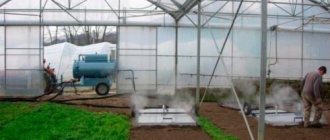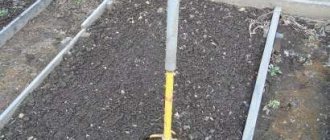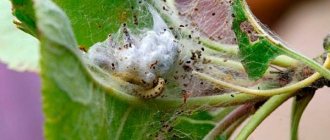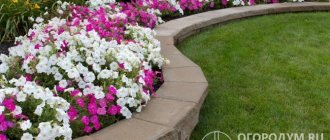How to lower soil acidity in autumn
Dolomite flour is needed mainly for light soils: sandy and sandy loam, they usually lack magnesium, and dolomite makes up for this deficiency.
Dolomite flour should be selected with the finest grinding and used for liming soils, primarily for slow crops, for example, for potatoes, fruit shrubs and trees.
By the way, fluff introduced under potato beds causes scab in potatoes - it does not tolerate excess calcium in the soil. Therefore, dolomite flour or ash should be used to deoxidize the soil in the potato plot.
The norm of dolomite flour for acidic soil for the main application is 500-600 g per sq. meter of land, for moderately acidic soil 400-500 g, for slightly acidic soil 350-400 g.
A 10 liter bucket contains about 12-15 kg of dolomite flour.
Wood ash is suitable for deoxidation, but this is far from the best option, since it does not compensate for the calcium deficiency, which many vegetables - nightshades - need so much: tomatoes, peppers, suffering from a lack of this element, vertex rot. Ash is good as a complex fertilizer, but a lot of it is required for the main deoxidation of the soil.
But if the acidity across the site is uneven, for example, in previous years, lumpy lime was introduced, which lay unevenly, then ash is quite suitable. That is, ash is good for repeated, supporting deoxidation of the site.
Application rate for liming (main application) - three liter cans per 1 sq. meter is about 600 g of ash.
For re-deoxidation (in the second year after the main one) 1/3 of a three-liter jar per 1 sq. meter is about 2 glasses or 200 g of ash.
A 10 liter bucket contains approx. 5 kg ash. If your ash is not wood, but peat, its norms need to be increased by 1.3-1.5 times.
Similar posts
A mineral with a crystalline structure is called dolomite. It has a glassy luster and can have various colors: brown, reddish, white, gray.
If you grind this mineral, you get flour, which contains calcium and magnesium.
When flour is added to the ground, the plant has advantages:
- Receives food.
- Develops better.
- Helps the plant fight pests.
- The harvest is of high quality.
- The shelf life of the fruit is increased.
- Radionuclides are neutralized.
- Participates in plant photosynthesis.
- The root system is improved due to calcium in the soil.
- Increases the efficiency of the applied fertilizers.
- The plant receives molybdenum, nitrogen, potassium, phosphorus.
- Affordable price.
Disadvantages:
- Not suitable for all plants.
- Overdose is dangerous.
Application
- Dolomite flour is used in construction, horticulture, floriculture, glass and sugar industries, and metallurgy.
- The product acts as a natural mineral fertilizer that does not require various additives.
- Agriculture uses flour in various fields. Since when it is introduced, acidity is normalized and the composition of the soil is improved with nutrients.
- If the soil is neutral, then you should not add flour, in this situation, it is used as an effective tool in the fight against pests.
- Dolomite flour is widely used as a fertilizer due to its affordable price and shelf life, which has no limitations.
For many gardeners, acidic soil becomes a real problem.The most popular and demanded garden crops grow only on slightly acidic or neutral soils. We will tell you today how to deacidify the soil in the fall.
Dolomite flour is a powder made from crushed rock. This substance reduces the level of acidity, improves the structure of the upper soil layer. Flour goes on sale in pure form without impurities and additives. Deacidification of the soil is possible in spring and autumn.
How much dolomite flour to apply? The rates of dolomite flour application for soil deoxidation depend on the soil acidity indicators:
- With moderately acidic soil - 45 kg / 100 sq. m.
- With strongly acidic (up to pH4.5) - 50 kg / 100 sq. m.
- With slightly acidic - 35 kg / 100 sq. m.
The type of soil also affects the consumption of flour. On heavy soil, loam and clay, the amount of fertilizer increases by 20%, and on sandy soils, it is reduced by 1.5 times.
It is considered best to apply dolomite flour before fertilizing. She organically interacts with them.
If the soil is intended for growing vegetables, dolomite flour is applied half a month before planting. This will prevent the contamination of crops with fungal diseases. The introduction of dolomite flour improves the properties of the soil in a greenhouse.
It is more expedient to deacidify the soil with lime in the fall. During the winter, a neutralization reaction will occur in the soil. For liming, mineral additives of the following types are used:
- Slaked lime, or fluff. You can get it yourself by extinguishing ordinary lime with water. Fluffy neutralizes acidic soil.
- Crushed limestone. The optimal and affordable option. Magnesium carbonate is usually added to such a mixture.
Limestone for deoxidation is applied locally throughout the entire site or in a specific bed. If you cannot apply lime in the fall, you need to use other types of fertilizer. How to calculate the consumption rate? To deacidify sandy loam and sandy soil for 10 sq. meters bring a kilogram of limestone. To deoxidize loamy and clayey soils, it is necessary to triple the amount.
The fertilization rate also depends on the depth to which the fertilizer is applied. The consumption rate increases if lime is laid to a depth of about 20 cm. If limestone is consumed more than 500 g per square meter, the deoxidation process must be planned for three years.
Chalk is a naturally occurring substance that is very often used to deoxidize the soil in the garden. It reduces acidity by acting gently on the soil. It needs to be brought in at the dacha annually, not necessarily before winter. In the spring, a month before the planned planting date, chalk is evenly scattered over the surface of the territory. Then they start digging.
Effectively apply chalk in early spring on snow. It will melt, and the meltwater will carry the chalk particles deep into the soil. It is not recommended to add too much and often chalk, as it accumulates in the soil, causing it to become saline.
Ash is an effective soil deoxidizer, but not the best one. Ash is best used on soil that requires weak deoxidation. To affect the acidity level to a greater extent, it is necessary to add a lot of ash, and this will lead to the accumulation of too many trace elements in the soil. It is safe to say that ash is more a top dressing than a deoxidizer.
In the event that ash still needs to be used, it is worth giving preference to birch ash. It contains a large amount of phosphorus and potassium. Its rate per square meter is about 10 kg.

How often is deoxidation carried out? It depends on many factors, the main of which is the acidity level. Strongly acidic soils need to be deoxidized every four years. The main deoxidation on slightly acidic soils is carried out every five to eight years.
Every year it is necessary to carry out activities aimed at maintaining neutral acidity. You can limit yourself to adding a small amount of dolomite flour before planting crops, this will help neutralize the acidic soil. In specialized stores, you can find a large number of special mineral complexes that are designed to regulate the level of soil pH. They are enriched with various microelements, in most cases they are additionally used as a top dressing.
All the above methods of soil deoxidation can be combined or alternated with each other. Since spring, manure and dolomite flour are introduced to a shallow depth during digging. Then spill with a solution of Baikal-EM1. It is a biological product that contains special soil bacteria that accelerate the decomposition process. 2 weeks after treatment, they start sowing siderates.
Deacidification can have a negative effect on the amount of nutrients, so it must be carried out competently, observing the recommended timing and consumption rates. If too much lime is added to the soil, potassium, manganese, iron, boron will turn into compounds that cannot be absorbed by plants. Cultures begin to suffer from their lack.
With the combined use of nitrogen-phosphorus fertilizers and deoxidizers, unpleasant consequences are also observed, plants stop absorbing phosphorus and nitrogen, which affects their growth. To prevent this from happening, deoxidation must be carried out in the fall, and nutritious fertilizers must be applied in the spring. Then they will not interfere with each other.
After the main deoxidation has been carried out, it is not recommended to apply mineral fertilizers to the soil for the first two years. You can use organic matter or limit yourself to foliar dressing on the sheet.
Violation of the acidity of the soil, first of all, is fraught with the fact that the fertilizers applied are not absorbed by the plants due to the acidic environment. In addition, some types of beneficial bacteria and microorganisms cannot exist in such land, which negatively affects the amount of the grown crop.
The acidic earth is characterized by increased density, which makes the process of oxygen supply to the roots difficult, and the acid-base balance is disturbed in it.
Each method can be used.
The advocates of natural farming are advised to lower the acidity of the soil by sowing green manure, which, in addition to raising the pH:
- suppress the growth of weeds;
- enrich the soil with nitrogen;
- improve the composition of the soil, making it looser;
- help in getting rid of pests (wireworm, nematodes);
- serve as an organic fertilizer.
The liberated land is leveled with a rake and green manure seeds are scattered over it.
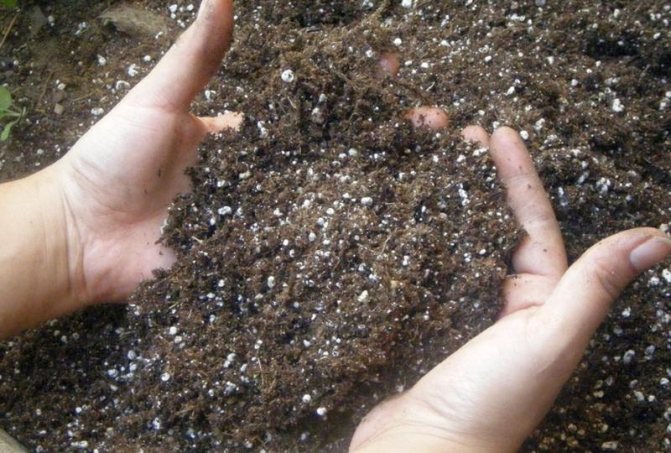

Dolomite flour is obtained by crushing dolomite. The composition contains magnesium and calcium, which are washed out from acidic soils. Soil deoxidation with dolomite flour leads to the solution of a number of problems:
- the soil is enriched with nutrients;
- the growth of garden crops is increasing;
- the sour earth, which has fallen into disrepair, comes back to life.
Negative results are obtained when:
- non-compliance with the dose;
- joint application with various incompatible preparations (ammonium nitrate, urea, superphosphate, manure);
- pH level above 6.
Dolomite flour (limestone flour)
Dolomite flour is needed mainly for light soils: sandy and sandy loam, they usually lack magnesium, and dolomite makes up for this deficiency.
Dolomite flour should be selected of the finest grinding and used for liming soils, primarily for slow crops, for example, for potatoes, fruit shrubs and trees.
By the way, fluff introduced under potato beds causes scab in potatoes - it does not tolerate excess calcium in the soil.Therefore, dolomite flour or ash should be used to deoxidize the soil in the potato plot.
The norm of dolomite flour for acidic soil for the main application is 500-600 g per sq. meter of land, for moderately acidic soil 400-500 g, for slightly acidic soil 350-400 g.
A 10 liter bucket contains about 12-15 kg of dolomite flour.
Acidic soils: what to do
First you need to determine what type of soil is on the site. To determine, you will need litmus paper or a special device - a PH meter. Unfortunately, not all summer residents own such a device. Many novice gardeners want to learn how to determine the acidity of the soil on their own using folk remedies. There are several methods.
The method for determining the acidity of the soil by weeds is very productive. There are indicator plants that can help you do this. Dandelion, horse sorrel, plantain, horsetail grow in large quantities on acidic soil.
You can check the acid level on the beets growing in the area. If the plant has green tops with reddish veins, the soil is slightly acidic, if the tops are red, the soil is highly acidic. Pure green tops are found in beets that grow on neutral soil.
For different horticultural crops, the soil acidity index may differ. For example, the optimal soil acidity for raspberries is pH 5.8 - 6.2. In acidic soil, raspberry bushes will die, but blueberries prefer soil with an indicator of less than 5 units. To understand whether you need to deacidify or acidify the soil, you can use the table.
Soil deacidification or liming is the only method to reduce soil acidity. It is necessary to apply materials containing lime. The amount and dosage depend on the initial acidity and texture of the soil.
Liming maintains a positive effect on the soil for several years. On heavier soils it takes longer, on light soils it is less, therefore, on loamy soils, the main liming is carried out once every 5-7 years, on sandy soils - once every 4-5 years, on peat soils about once every three years. The more humus the soil contains, the more lime can be applied. But in general, the calculation is as follows: a dose of lime in 500 g per 10 sq. m increases the pH by an average of 0.2 units.
The main material that allows you to lower the acidity of the soil is lime. It is customary to consider the calcium content in quicklime as 100% (all other materials are compared with this indicator).
Quicklime is never applied in its pure form - it burns out all soil microorganisms, violates the integrity of the soil as a biosystem. In addition, the usual lime of a heterogeneous structure is small and large lumps, when liming the application rates are different - where it is more, where it is less.
Therefore, the following materials are used for deoxidation:
- Slaked lime (fluff) - up to 130% lime
- Dolomite flour contains - 95-108% lime
- Burnt dolomite flour - 130-150%
- Lime tuff contains - 75-95% lime
- Lake lime (drywall) - 80-100%
- Cement dust about 80%
- Chalk - 90-100%
- Wood and peat ash - 30-50% lime
Soil liming
The first is the main one, during the development of a site or redevelopment, when a deep digging is being prepared. The main introduction of lime (fluff, dolomite, chalk) is carried out once every few years.
Re-liming - annually in smaller doses to maintain acidity after the main application.
If the acidity of the site is uneven (somewhere acidic, somewhere weakly acidic), then liming is carried out either in the area under crops, the most demanding soil to the reaction and tolerating liming well. Or, if you follow a crop rotation in the garden, the entire plot requires liming.
The main liming when laying an orchard should be carried out 1-2 years before planting garden shrubs and trees. To prepare the soil for the garden - from autumn.
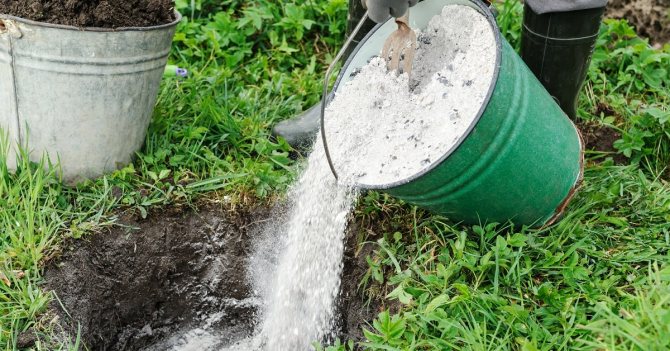

Lime application technique: by evenly spreading over the area from autumn for digging the soil, i.e. to a depth of about 20 cm. The key to success is a well-calibrated uniformity of liming, the more evenly the lime material is applied, the better.
Why in the fall: many lime materials are strong alkalis, calcium hydroxide easily combines with water, and quickly changes the reaction of the soil from acidic to neutral, and sometimes to alkaline. At this time, some of the nutrients, especially phosphorus, pass into a form inaccessible to plants and cease to be absorbed by them. Therefore, for some time after liming, the soil is unbalanced for planting and plant growth. It takes 3-6 months to stabilize it, so we will lime it in the fall.
Later, when the land began to be reclaimed, the beds were built, vegetables, flowers, berries are grown, and after them green manure herbs, maintenance deoxidation is required - in small doses in order to maintain the balance of acidity and compensate for the removal of calcium during plant growth. The application can be carried out in the fall and during the preparation of the soil in the spring: in pits and holes, or scattered over the surface and repaired with a hoe.
It is imperative to deoxidize the soil for such sensitive crops as beets, cabbage, onions, garlic, spinach, celery, carrots.
- Lime and drywall (lake lime), dolomite flour, tuff and ash can be applied simultaneously with organic fertilizers
- It is undesirable to add slaked lime, burnt dolomite flour, chalk, cement dust and defecate together with organic matter - this leads to a loss of nitrogen in the form of ammonia, and an excess of calcium, which is difficult for plants to tolerate.
First you need to determine what type of soil is on the site. To determine, you will need litmus paper or a special device - a PH meter. Unfortunately, not all summer residents own such a device. Many novice gardeners want to learn how to determine the acidity of the soil on their own using folk remedies. There are several methods.
The method for determining the acidity of the soil by weeds is very productive. There are indicator plants that can help you do this. Dandelion, horse sorrel, plantain, horsetail grow in large quantities on acidic soil.
You can check the acid level on the beets growing in the area. If the plant has green tops with reddish veins, the soil is slightly acidic, if the tops are red, the soil is highly acidic. Pure green tops are found in beets that grow on neutral soil.
With excessive acidity of the soil, it is reduced artificially. Certain components are introduced: dolomite flour, slaked lime, chalk, gypsum. They also sow green manures, which increase the air permeability of the soil, fight weeds and improve the quality of the soil.
Description and characteristics
Dolomite flour is a powder. It is produced from carbonate minerals. In particular, from dolomite - a material of a crystalline structure, which can have different colors (from white to brown). Flour is prepared by crushing dolomite. Therefore, the deoxidizer looks like fine sand or powder.
Dolomite flour consists mainly of calcium and magnesium, which are lacking in acidic soils.
Note. The main reason for the increase in soil acidity is the intense displacement of calcium from the once neutral soil by hydrogen ions.
Properties
Experienced gardeners use this tool not only as a fertilizer, but also to resist diseases of garden plants.
Often, top dressing is applied to acidified soil that has become unsuitable for cultivation.
Crushed dolomite is important in preparation for the garden season, as it improves the growth of garden crops, enriches the soil with microelements.
Calcium from dolomite stimulates the development of rhizomes, and magnesium improves the process of photosynthesis.
This dressing is useful for vegetable crops (beets, potatoes, onions, carrots), fruit trees, berries (cherries, plums, cherries).And also for some herbs and cereals.
The positive effect can be achieved by applying both in open areas and in greenhouses, homemade greenhouses, indoor flower containers or pots.
It is irreplaceable on soils poor in magnesium, as well as on sandstones and sandy loam soils.
How to determine the acidity of the soil
Without special tests in the laboratory, you can determine the acidity by the weeds that stubbornly make their way on your land. It is especially worth worrying if horsetail, sorrel, plantain, heather breaks through, if mint strives to go into the weed, and hosts grow violently on the flower beds. On moderately acidic soils, coltsfoot, clover, wheatgrass and field bindweed grow, roses and chrysanthemums grow luxuriantly.
But do not forget that when testing the soil for acidity, we usually take a sample of the upper soil layer, and the roots of the plants go much deeper. Therefore, for the reliability of the determination, it is necessary to take soil samples from different depths (20 cm, 40 cm, 50-60 cm).
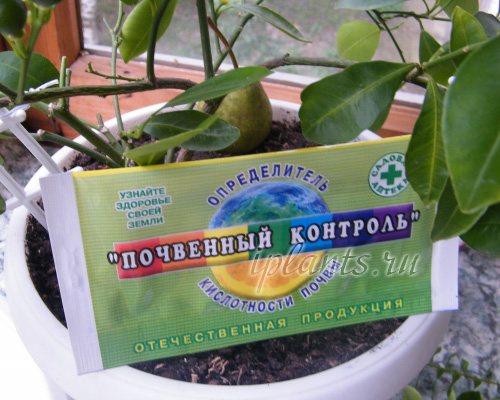

There is also testing of acidity for growing beets: acidity is reflected in the color of the tops: if the leaves of beets are completely red, the reaction of the soil is acidic; green with red streaks - slightly acidic; green leaves and red petioles - the soil is neutral.
There is no doubt that you have acidic soil if the site is located on a swampy forest, peat bogs next to quarries, if there are nearby groundwater.
If you are using soil acidity test strips, do not place them on a wet surface. Prepare an aqueous solution: for 2.5 parts of distilled water, take 1 part of the soil to be tested. Stir and let sit for 20 minutes, then dip the test strips into the solution.
Optimal soil acidity for fruit and berry bushes and trees:
- cherry, sea buckthorn, plum - pH 7.0
- apple, pear, gooseberry, currant - pH 6.0-6.5
- raspberries - pH 5.5-6.0
- strawberries, strawberries - pH 5.0-5.5
- vegetables - pH 6.0-7.0
With a reasonable approach to land cultivation, it is necessary to determine the type and acidity of the soil even before the first plants are planted. However, even if the soil on your site was originally named pH neutral, this could change over time. Fortunately, you do not need to go to a specialist to determine the acidity of the soil - there are simple and inexpensive methods that any gardener can do.
In order to find out the pH of the soil as accurately as possible, you will need to take a few teaspoons of soil from different parts of the site, buy a universal litmus paper at the pharmacy and conduct a simple experiment.
Wrap each portion of soil in a thick cloth, put in a glass and fill with distilled water in a 1: 1 ratio. After 5 minutes, take litmus papers and dip each in a separate glass for 1-2 seconds. The paper will change color, and the accompanying acidity scale will give you an idea of the pH and what action to take.
Don't have time to go for special tools? You can do with what is in every home, for example, 9% vinegar.
Determination of soil acidity using vinegar
Take the glass, place it on a dark surface. Pour 1 tsp on the glass. ground and pour in a small amount of vinegar. If abundant foam is formed, then the soil is alkaline, if there is foam, but very little of it, it is neutral, and if there is no reaction at all, the soil in the chosen place is acidic.
- What is the soil in your area - how to determine and improve the composition of the soil
Litmus Papers Wrong Acidity? Worried about dense lumps? Find out if everything is in order with the soil at the summer cottage!
Ordinary beets can also tell the level of soil acidity: on acidic soil, it grows with red leaves, on slightly acidic soil, with red veins on the tops, and on neutral soil, with green leaves and red petioles.
The acidity of the soil must be increased if the pH level is 5 units or higher.To increase the acidity, simple methods are used, for example, high peat is added to the soil. You can spill the soil with acidified water. Dissolve 2 tablespoons of citric or oxalic acid in a 10 liter bucket of water. Malic or acetic acid (9%) is suitable. Such acid will require 100 ml per 10 liters of water.
If the acidity of the soil is about 4 units, sulfur is used. They take about 70 g of the substance, make them per square meter of soil. You can limit yourself to adding peat to the garden soil when planting. Sawdust acidifies the soil well. They are scattered during planting, sometimes used as mulch. Sawdust takes a long time to decompose and acidifies the soil throughout the season.
For a slight acidification of the soil, compost or humus is added. If you add about 9 kg of compost or 3 kg of humus per square meter of area, the acidity of the soil increases by 1 unit. The acidification procedure must be carried out regularly, as the soil changes its acidity.
You can deoxidize the soil in different ways. For this, the following substances are used:
- dolomite flour;
- slaked lime;
- drywall;
- a piece of chalk;
- ash;
- green manure plants;
- complex deoxidizers.
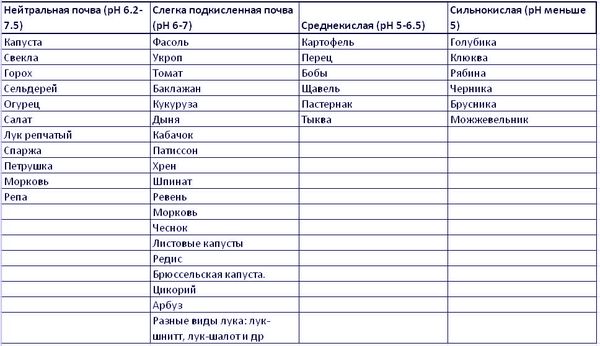

Some gardeners carry out soil deoxidation with cement. Its constituents are suitable for these purposes. Old cement, which has already lost its properties for construction, can be used instead of chalk or limestone. For 1 sq. meter will require 1-1.5 kg of this substance. But it is not recommended to get carried away with excessive application of cement to the soil. Otherwise, manganese, boron and phosphoric acid from the applied fertilizers will become inaccessible to plants.
Often, many gardeners believe that it is enough just to periodically fertilize the soil, and then it will be quite nutritious and will certainly give an excellent harvest. But this is not always enough.
Experienced gardeners and summer residents use another method of ennobling - soil deoxidation. In spring or autumn, they add some additives to the soil that make the soil pH more neutral and at the same time saturate it with the necessary natural trace elements.
Why, when and how to do it correctly, we will tell you today. Let's dwell on five simple methods that will be affordable and easy to use.
First you need to know that not all plants love acidic and alkaline soil. So, for example, sorrel and black currant love sour soil, but tomatoes, cucumbers and cabbage will grow poorly on it.
One summer cottage can have either the same acidity over the entire area, or completely different.
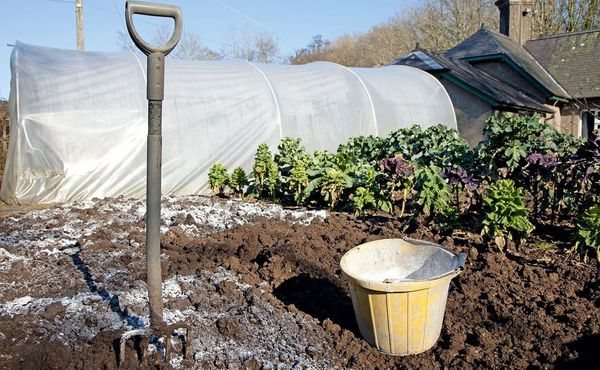

Therefore, before deciding to deacidify the soil in the spring, you should determine what pH level in each part of your vegetable garden or garden, and what you plan to grow there.
On the land with high acidity, many weeds grow, and cultivated varieties do not take root well, their root system develops poorly, and they often die for reasons unknown to the owner. A high pH level indicates that the earth contains a lot of hydrogen ions.
When the site owner tries to fertilize the soil and introduces additional mineral (or any other) fertilizers, hydrogen reacts with them, which is why they are converted, and the plant simply cannot use them for its own purposes.
Deacidification of the soil in spring or autumn will help reduce the level of aluminum and manganese, but other elements: magnesium, calcium, phosphorus, molybdenum and nitrogen - will be present in the required amount and will be perfectly absorbed.
Of course, absolutely accurate results can only be obtained in a laboratory. This is a good way, but not practical. Therefore, experienced gardeners have found for themselves some simple options for recognizing acidity.
Take two transparent containers and pour a teaspoon of earth into each. Add some 9% vinegar and stir.If the solution foams - the soil is alkaline, it foams quite a bit - neutral, air bubbles did not appear at all - acidic.
We read by plants
The acidity of the beet beds can be easily recognized. The plant will have green leaves, red petioles, and a poorly developed root system if the ground is alkaline. On green leaves, red streaks are weakly acidic. But if the leaves have a rich beet color, the beets grow large, well-developed - the soil is acidic.


Weeds will finally be useful. Where wheatgrass grows - the scourge of many summer residents, the land is slightly acidic. Wood louse loves sour, but bindweed and most vegetables - alkaline earth.
The deoxidation of the soil in the spring should be carried out, starting from the acidity of the earth: the higher it is, the more deoxidizers will need to be introduced. It is important not to overdo it and observe the dosage, because an excess of alkali will harm the earth even more than excessive acidity.
Most often, soil deoxidation is carried out in spring with lime. This is one of the simplest and cheapest options. It is slaked lime that is used, for this, a little water is added to the usual one and stirred. It should become loose by reacting with water. She is often called "fluff". Lime has the most pronounced neutralizing effect and is ideal for very acidic soils.
If you plan to deacidify the soil in the spring, the rates for the introduction of the finished "fluff" will be in the range of 50-150 grams per square meter of area. The degree of acidity of the earth should be taken into account. After the lime has been added to the soil, it should be mixed with the top layer of the earth (depth 15-20 cm).
Dolomite flour
The soil is also deoxidized in spring with dolomite flour. Such material will be more expensive than ordinary lime, but if possible, why not? Dolomite flour is also called lime flour (CaCO3).
It, like "fluff", is undesirable to introduce into the soil at the same time as saltpeter, superphosphate, urea or manure. Therefore, try to stay on one thing. It is useful to introduce dolomite flour just before planting crops, unlike the "fluff", it does not burn the plant.
It can be added to the ground at any time of the year, but usually it is autumn or spring.
Introduced at the following rate (per square meter):
- slightly acidic - 300-400 g;
- medium acid - 400-500 g;
- sour - 500-600 g.
Dolomite flour is not used for soils on which gooseberries, sorrel, blueberries and cranberries grow. Treatment with such a deoxidizer should be carried out every three years.
It will be useful to deoxidize the soil in spring with chalk. This additive is more neutral and will work well for soil with low acidity. Chalk grains should be small, no more than 1-2 mm.
- lime (liming);
- a piece of chalk;
- wood ash (soldering);
- dolomite flour;
- siderates;
- complex deoxidizing preparations.
Slaked lime
- The most accurate way to measure soil acidity is with a pH meter.
A handful of earth is taken and poured with vinegar. The appearance of bubbles indicates a neutral soil and a normal lime content. If there are no or few bubbles, this is a signal of acidic and slightly acidic soil. - Soil is dropped into a glass of grape juice. A change in the color of the liquid and the presence of bubbles also indicate neutral acidity.
- Indicator. Litmus paper acts as it.
- The surface layer of soil is removed by 5 cm and a small piece of land is recruited. Further, it is immersed in water in a ratio of 1: 2.5, if this is an ordinary soil, for a peat ball, a ratio of 1:25 should be taken.
- Mix everything well and lower the litmus paper.
- The appearance of a red tint on the indicator signals acidic soil, green - alkaline.
- Acid meter or pH meter. If you need to know exactly the acidity level of the earth, then use this device. It is lowered into the ground, and the readings are recorded. The pH will be very accurate.
Major mistakes
Despite the outward simplicity of using dolomite flour, not all gardeners manage to do it right.
Among the most common mistakes:
- Failure to comply with the dosage of fertilization. Despite the fact that everything is written in detail on the package with top dressing, not all gardeners follow the instructions. As a result, there is no longer any need to wait for the benefit from the introduction.
- The use of fertilizer in combination with manure and complex fertilizing, which were mentioned above. It is categorically impossible to do this.
- Dolomite flour will not please those plants that thrive on acidic soils. We are talking about cranberries and blueberries, sorrel and gooseberries.
The use of green manure plants
Those gardeners who prefer organic farming use green manure plants to deoxidize the soil. No need to worry about excess calcium and calculate application rates. The use of this method, subject to the rules of crop rotation, makes it possible to do without the use of dolomite, limestone and other mineral fertilizers.
Phacelia has proven itself to reduce soil acidity. Also, the plant is an excellent honey plant, attracting a large number of pollinating insects to the site. Phacelia is planted in the spring, it has a beneficial effect on the soil throughout the growing season, by the fall you can already feel that the acidity of the soil has decreased.
Those gardeners who prefer organic farming use green manure plants to deoxidize the soil. No need to worry about excess calcium and calculate application rates. The use of this method, subject to the rules of crop rotation, makes it possible to do without the use of dolomite, limestone and other mineral fertilizers.
Phacelia has proven itself to reduce soil acidity. Also, the plant is an excellent honey plant, attracting a large number of pollinating insects to the site. Phacelia is planted in the spring, it has a beneficial effect on the soil throughout the growing season, by the fall you can already feel that the acidity of the soil has decreased.
Drywall
Lake sludge containing calcium carbonate. It goes on sale in the form of a loose crumbly powdery mass. Drywall is used for cement production and soil improvement. In some regions it is called "earthy gypsum", "lake lime". Experts know this substance as limnocalcite.
Drywall is introduced in the fall at a dosage of 300 gr. sq. m. 100 gr. the substance contains up to 96% calcium. The rest is magnesium and mineral impurities.


The right pH level for the vegetable garden
First you need to understand the concept of soil acidity. This term is understood as the ability of the earthen mixture to exhibit the properties of acids. The indicator is measured in numbers from 0 to 14. It is one of the indicators of soil fertility. In the process of characterizing soil pH, the following types of acidity are used: potential, actual, exchangeable, hydrolytic.
The optimum pH is 6.5-7. It is considered neutral. Weakly acidic soils have an acidity in the range of 5-6.5, moderately acidic - from 4 to 5, strongly acidic - less than 4. In the agrarian business, an acidity indicator in the region of 3.5 - 8.5 is considered acceptable, it all depends on the type of plant. For example, many fruit crops like slightly acidic and neutral soil.


Phacelia
Another easy way, and most importantly - completely natural, and even beautiful! This plant is planted throughout the site, then mowed and distributed over the ground. This can be repeated several times, the phacelia grows very quickly - in 20 days.


Every experienced gardener knows not to throw away eggshells. It is collected, dried, crushed and added to the soil. So the earth receives a lot of useful microelements, and at the same time its acidity decreases.
Here are some simple and helpful tips for those who love and practice growing tasty and healthy foods on their site.All these examples are simple enough and will not take a lot of time. It is enough to carry out such a refinement once every 3-4 years. The earth will certainly thank you for your labors - it will give you an excellent and rich harvest.
My grandfather taught me to deacidify the land for the beds. He always said: "On such a site you will only collect a large harvest of weeds, but you will not work out with vegetables." At first we did it by eye, and when I mastered the Internet and read about the test strips, and then ordered them, we began to reduce the acidity to a strictly defined rate.
Top 5 ways to deoxidize
If it is worth fertilizing the soil annually (and ideally, several times per season), then you can deoxidize the site every three years... Although, of course, a lot depends on the initial qualities of the site and the method you choose.
It is worth checking the quality of your soil twice a year: in the first months of spring and autumn.
Liming
The most popular, good old way.
Finely ground lime must be added to the soil (you can even sprinkle it through a sieve beforehand). Lime must be extinguished (that is, I mean fluff). You need to deepen the lime by about 20 cm.
- slightly acidic area - about 20 kg per hundred square meters;
- medium acid - 40 kg;
- high acidity - from 50 to 70 kg.
By the way! Liming is a method that will improve the structure of your soil for several years in advance. That is, there is no need to add lime every autumn or spring, otherwise the soil will be oversaturated with limestone, and, again, the yield of most crops will suffer (in soil oversaturated with calcium, plants will grow worse root mass).
If you are following a crop rotation, you need to process the entire garden at once. If the site is small and it is all divided into beds, select only those plants on which they like neutral soil, and only lime them.
The liming of the garden (for fruit trees) should be carried out in advance - several years before their planting.
Dolomite flour (also known as limestone)


This material is more expensive than lime, but is considered more useful for the garden: it improves the mineral structure of the soil, saturating it with magnesium and calcium - important "participants" in the process of photosynthesis. It is also believed that vegetables grown on such land suffer less from harmful insects and are better stored in winter.
The substance is not toxic to animals or people, but during work you need to wear protective gloves, and if flour gets on your skin, wash it off thoroughly.
Flour should be added every 3-5 years.
It is very important that the flour was the smallest fraction.
- slightly acidic soil - about 35 kg per hundred square meters;
- medium acid - 45 kg;
- high acidity - 55 kg.
This substance is especially beneficial for nightshades.
Wood ash
This deoxidation enriches the soil nitrogen, which is especially important for plants that are valued for their foliage or shoots. But there is no calcium here, so it is better to use ash as not the main, but an additional deoxidizer, or mixing it with other substances (chalk, lime).
For 1 square of land, take a liter of water and 200 g of ash. If the ash is peat, add 350 g of such ash to the same liter of water.
Adding chalk
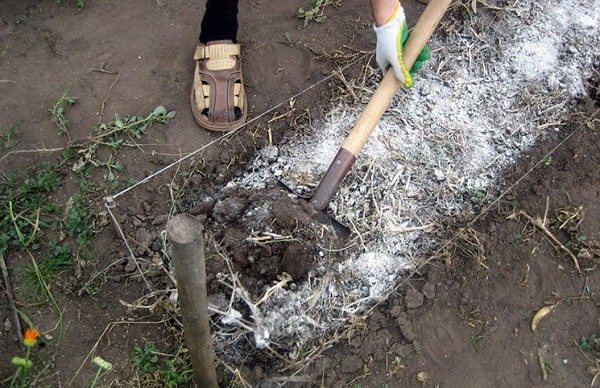

Another calcium-rich substance.
As with dolomite flour, care must be taken that the chalk grains do not exceed 1 mm in diameter.
- weak acidity - 10 kg per hundred square meters;
- medium - 20 kg;
- high - 30 kg.
This substance can be replaced with: cement, used plaster, alabaster, and also powdered eggshells.
Siderata
These plants have a lot of advantages: they enrich the soil with useful microelements (copper, zinc, phosphorus, magnesium, calcium and others), protect the garden from the dominance of weeds, and are environmentally friendly.
Of course, they will not fundamentally change the condition on the site, but if the acidity of the soil is slightly higher than necessary, they can correct the situation. True - in a couple of years.
Let's summarize
- It is very important to determine the acidity of the soil in the garden, in the garden or flower garden - in the soil with too high acidity and the yields are lower, and the flowers are worse.
- You can check the acidity either in a rustic way (noticing which weeds take root on the site - moss loves acidic soil most of all), or by buying a set of litmus papers.
- You can deoxidize the earth by adding fine lime, wood ash, dolomite flour, chalk when digging or plowing. Also, not dramatically, but nevertheless, the sown and dug up green manures in time will help to improve the acidity of the site.
Sometimes people confuse acidic and alkaline soil, clay and sandy. This video will help you finally understand the types of soil.
The yield of garden crops depends not only on the fertility of the soil and the quality of plant care, but also on the level of acidity of the soil. Acidic soils are not favorable for the growth of most crops, therefore, to ensure normal growth and ripening of fruits, it is necessary to deacidify the soil.


